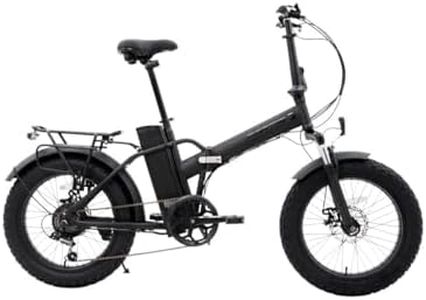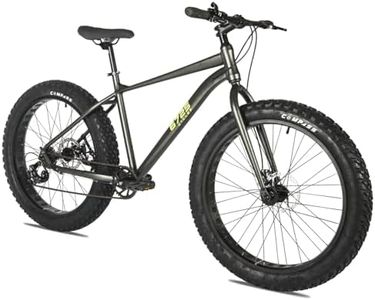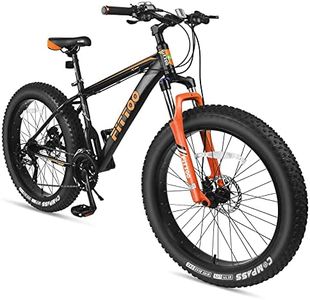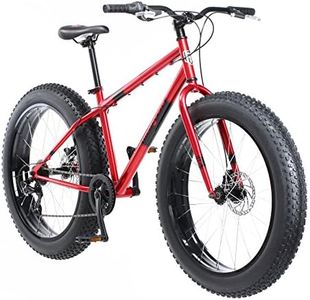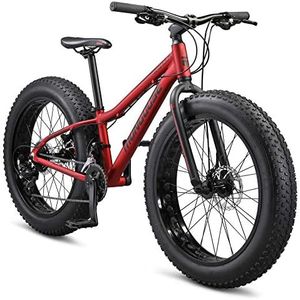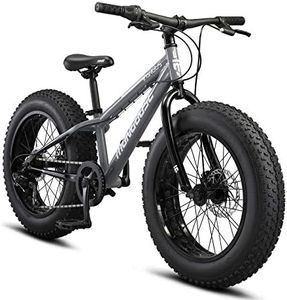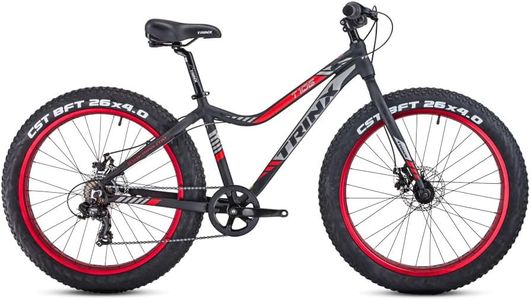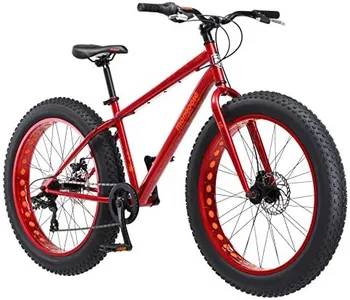We Use CookiesWe use cookies to enhance the security, performance,
functionality and for analytical and promotional activities. By continuing to browse this site you
are agreeing to our privacy policy
10 Best Mens Fat Tire Bikes
From leading brands and best sellers available on the web.Buying Guide for the Best Mens Fat Tire Bikes
Choosing the right men's fat tire bike can make a big difference in how much you enjoy riding, especially on challenging terrains like snow, sand, or muddy trails. Fat tire bikes are designed with wider tires to provide extra stability and grip, but they differ in many features that affect comfort, control, and where you can ride them best. It's important to think about where you'll be riding the most, how much you value comfort versus performance, and your experience level. Understanding the key specifications will help you narrow down options and select the bike that matches your needs best.Tire WidthTire width refers to how wide the tires on the bike are, usually measured in inches. The main advantage of wider tires is that they offer more surface area, increasing traction and allowing you to ride more easily on soft, loose, or uneven surfaces like sand or snow. Tire widths on fat bikes typically range from about 3.8 inches to over 5 inches. Narrower fat tires (around 3.8 to 4.5 inches) might roll faster and feel a bit lighter, making them better for mixed terrain or packed trails. The widest tires (4.8 inches and above) provide maximum float for very loose or soft conditions but can be heavier and a bit harder to pedal on harder surfaces. If you mostly ride on snow, sand, or very loose ground, go wider; for a mix of terrains, something in the middle may suit you better.
Frame MaterialThe frame material determines the bike’s weight, strength, and ride feel. Common materials include steel, aluminum, and sometimes carbon fiber. Steel frames are usually more durable and absorb bumps well, making them comfortable, but they tend to be heavier. Aluminum frames are lighter and resist rust, which is nice for wet or snowy environments, though they may feel stiffer. Carbon fiber is the lightest and can be very comfortable by absorbing vibrations, but it’s often more expensive and needs to be handled carefully. If you want durability and comfort for rugged rides, steel may be your pick; for lighter weight and easy handling, aluminum is great; for the lightest and smoothest ride, carbon fiber is ideal if you’re experienced and want top performance.
DrivetrainThe drivetrain is the system of gears and chains that lets you shift and adjust how hard it is to pedal. Fat tire bikes often have a wide range of gears because you might be pedaling through deep sand or up steep, muddy hills. Simpler drivetrains with fewer gears (single front chainring) are easier to use and need less maintenance, but having more gears (multiple front or rear sprockets) gives you a broader choice for different terrains. For mostly flat rides or if you want things simple, fewer gears are fine. If you plan to tackle hills or rough terrain, more gears give you flexibility and make tough sections easier.
SuspensionSuspension refers to any shock-absorbing part on the bike – typically in the fork (front) or frame. Many fat tire bikes are 'rigid,' with no suspension, because the big tires themselves absorb a lot of bumps. Some have front suspension for extra comfort on rough trails. Rigid bikes are usually lighter and require less upkeep, suitable if your trails are mostly soft or not too bumpy. If you ride a lot on rocky, root-filled, or uneven ground, a bike with at least front suspension can reduce fatigue and increase control.
BrakesBrakes keep you safe and in control, especially when riding downhill or in slippery conditions. Fat tire bikes often use disc brakes, which come in 'mechanical' (cable-operated) and 'hydraulic' (fluid-operated) types. Hydraulic disc brakes give you more stopping power and work better in mud and snow, but they can be more difficult to maintain. Mechanical brakes are simpler and easier to fix on your own, but might need more hand strength and don't stop as quickly when it's very wet or muddy. Hydraulic is ideal for demanding terrain or regular wet, snowy conditions; mechanical works well for casual use and ease of maintenance.
Wheel SizeThe wheel size combines the tire and rim diameter, usually 26-inch or 27.5-inch on most fat tire bikes. Smaller wheels (26-inch) can feel a bit nimbler and easier to turn, especially for technical trails or riders with shorter legs. Larger 27.5-inch wheels roll over obstacles more easily and may keep speed better on longer rides. If you value quicker handling and plan to ride technical trails, 26-inch is good; if you want smoother rides with easier rolling over rough edges, 27.5-inch might be better.
Fit and Frame SizeFit is about how the bike matches your body, based on your height and leg length. Getting the correct frame size makes riding more comfortable and prevents injuries. Manufacturers usually have sizing charts (like small, medium, large, or numbered sizes) to guide you. Trying a bike before buying is ideal, but measuring your inseam and comparing it to the size guide can help. Always pick a frame that lets you stand over comfortably and reach the handlebars without stretching or feeling cramped. The right size is crucial for confidence, control, and comfort wherever you ride.


